Maomi.Core
Maomi.Core 是一个模块化和自动服务注册包,以简单和便捷的方式实现项目模块化和注册服务配置。Maomi.Core 是一个很简洁的包,可以在控制台、Web 项目、WPF 项目等项目中使用,在 WPF 项目中结合 MVVM 可以大量减少代码复杂度,让代码更加清晰明朗。
基于 ASP.NET Core 开发的 Web 框架中,最著名的是 ABP,ABP 主要特点之一开发不同项目(程序集)时,在每个项目中创建一个模块类,程序加载每个程序集中,扫描出所有的模块类,然后通过模块类作为入口,初始化程序集。
使用模块化开发程序,好处是不需要关注程序集如何加载配置。开发人员开发程序集时,在模块类中配置如何初始化、如何读取配置,使用者只需要将模块类引入进来即可,由框架自动启动模块类。
开始顺序实例初始化所有模块类。
首先扫码模块所在的类型,把所有模块的类型扫描后,扫描每个类型时,都会出发模块所在的类型过滤器。
快速入手
创建 Demo1.Api、Demo1.Application 两个项目,在 Demo1.Application 在中引入最新的 Maomi.Core 包。

每个项目都应该有一个模块类,分别创建 ApplicationModule.cs、ApiModule.cs,模块类需要实现 IModule 接口。
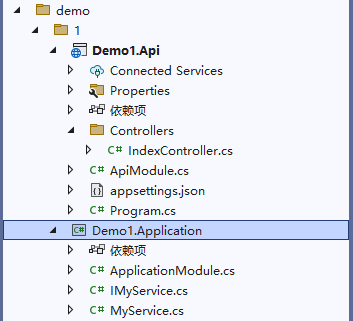
Demo1.Application 项目的 ApplicationModule.cs 文件内容如下,其构造函数注入了 IConfiguration,模块类中可以使用依赖注入,可以注入一些 WebApplicationBuilder 默认注册的服务。
public class ApplicationModule : IModule
{
// 模块类中可以使用依赖注入
private readonly IConfiguration _configuration;
public ApplicationModule(IConfiguration configuration)
{
_configuration = configuration;
}
public void ConfigureServices(ServiceContext services)
{
// 这里可以编写模块初始化代码
}
}
或者什么都不注入:
public class ApplicationModule : IModule
{
public void ConfigureServices(ServiceContext services)
{
// 这里可以编写模块初始化代码
}
}
在 Demo1.Application 项目里,如果需要将 MyService 注册到容器中,在类型上加上 [InjectOnScoped] 特性即可。
public interface IMyService
{
int Sum(int a, int b);
}
[InjectOnScoped] // 自动注册的标记
public class MyService : IMyService
{
public int Sum(int a, int b)
{
return a + b;
}
}
等同于:
service.AddScoped<IMyService, MyService>();
上层模块 Demo1.Api 中的 ApiModule.cs 可以通过特性注解引用底层模块。
using System.Reflection;
[InjectModule<ApplicationModule>] // 指明依赖了 ApplicationModule 模块
public class ApiModule : IModule
{
public void ConfigureServices(ServiceContext services)
{
// 这里可以编写模块初始化代码
}
}
最后,在程序启动时配置模块入口,并进行初始化。
var builder = WebApplication.CreateBuilder(args);
builder.Services.AddControllers();
builder.Services.AddEndpointsApiExplorer();
builder.Services.AddSwaggerGen();
// 注册模块化服务,并设置 ApiModule 为入口
builder.Services.AddModule<ApiModule>();
var app = builder.Build();
模块
Maomi.Core 也支持从程序集中弱引用模块类,即不直接调用模块类,而是动态扫描识别出模块类。
模块使用依赖注入
每个模块都需要实现 IModule 接口,其定义如下:
如果是单纯模型类模块或者纯接口抽象模块,则是没必要为此程序集添加模块。
/// <summary>
/// 模块接口.
/// </summary>
public interface IModule
{
/// <summary>
/// 模块中的依赖注入.
/// </summary>
/// <param name="context">模块服务上下文.</param>
void ConfigureServices(ServiceContext context);
}
在 ASP.NET Core 配置 Host 时,会自动注入一些框架依赖的服务,如 IConfiguration 等,因此在 开始初始化模块服务时,模块类的构造函数可以获取到已经注入的服务。
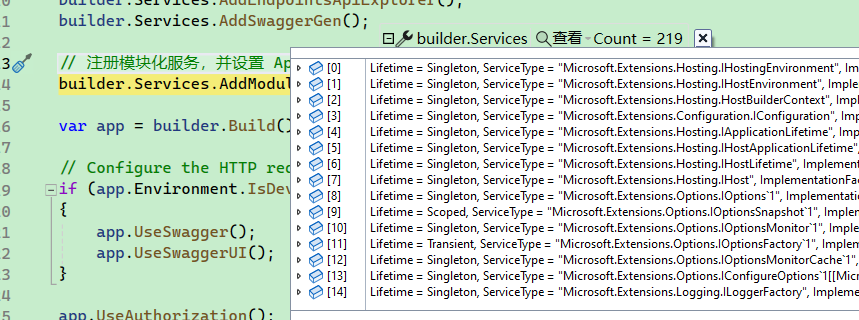
可以在模块类的构造函数注入想要的服务。
[InjectModule<ApplicationModule>]
public class ApiModule : IModule
{
private readonly IConfiguration _configuration;
private readonly IHostEnvironment _hostEnvironment;
public ApiModule(IConfiguration configuration, IHostEnvironment hostEnvironment)
{
_configuration = configuration;
_hostEnvironment = hostEnvironment;
}
public void ConfigureServices(ServiceContext context)
{
var configuration = context.Configuration;
context.Services.AddCors();
}
}
除了可以直接在模块构造函数注入服务之外,还可以通过 ServiceContext context 获取服务和配置。
/// <summary>
/// 模块上下文.
/// </summary>
public abstract class ServiceContext
{
protected readonly IServiceCollection _serviceCollection;
protected readonly IConfiguration _configuration;
protected readonly List<ModuleRecord> _modules;
/// <summary>
/// Initializes a new instance of the <see cref="ServiceContext"/> class.
/// </summary>
/// <param name="serviceCollection"></param>
/// <param name="configuration"></param>
internal ServiceContext(IServiceCollection serviceCollection, IConfiguration configuration)
{
_serviceCollection = serviceCollection;
_configuration = configuration;
_modules = new List<ModuleRecord>();
}
/// <summary>
/// 容器服务集合.
/// </summary>
public IServiceCollection Services => _serviceCollection;
/// <summary>
/// 配置.
/// </summary>
public IConfiguration Configuration => _configuration;
/// <summary>
/// 已识别到的模块列表.
/// </summary>
public IReadOnlyList<ModuleRecord> Modules => _modules;
}
例如,使用 context.Services 可以手动注册服务到容器中,使用 context.Modules 可以获取模块和程序集的相关信息。
context.Modules 里面只记录了跟当前项目关联的模块类所在的程序集,可以避免在使用不同的框架时重复扫描项目所有的程序集。
public void ConfigureServices(ServiceContext context)
{
var configuration = context.Configuration;
context.Services.AddCors();
context.Services.AddScoped<IMyService, MyService>();
// 注册 CQRS 服务.
context.Services.AddMediatR(cfg =>
{
cfg.MaxTypesClosing = 500;
cfg.AddOpenBehavior(typeof(TraceBehavior<,>));
cfg.RegisterServicesFromAssemblies(context.Modules.Select(x => x.Assembly).ToArray());
});
}
例如,使用 MediatR 框架需要添加程序集,使用 AutoMapper 也需要添加程序集,使用 AppDomain.CurrentDomain.GetAssemblies() 会将非常多的程序集一起添加进去,由于 MediatR、AutoMapper 等框架会反射扫描所有程序集,导致项目启动时会有点慢。
使用 context.Modules 则只会注册有用的模块类所在的程序集,例如 上面的 Demo1 解决方案中,context.Modules 里面只有 Demo1.Application、Demo1.Api,可以避免引入其它程序集,只关注当前项目的程序集。
ModuleCore 抽象类
ModuleCore 是一个实现了 IModule 接口的抽象类,主要是多了一个 TypeFilter 方法,在扫描程序集的类型时会调用该方法,开发者可以通过此方法灵活处理一些类型。
/// <summary>
/// 模块过滤器接口.
/// </summary>
public abstract class ModuleCore : IModule
{
/// <inheritdoc/>
public abstract void ConfigureServices(ServiceContext context);
/// <summary>
/// 扫描每个类型时会调用该接口.
/// </summary>
/// <param name="type"></param>
public abstract void TypeFilter(Type type);
}
如下所示,框架扫描到一个类型时,触发了 TypeFilter 函数,开发者可以识别该类型,然后进行相应的处理。
public void TypeFilter(IServiceCollection services, Type type)
{
if (type.IsClass && !type.IsAbstract)
{
if (type.IsGenericType && type.GetGenericTypeDefinition() == typeof(ITypeConverter<,>))
{
services.AddScoped(type);
}
}
}
项目里面可能会有很多第三方的框架以及自己编写的组件,如果每个框架都把所有程序集的类型都扫描一遍,会导致启动耗时变大,而且这个过程也是重复的,通过 TypeFilter 可以减少重复扫描过程。
模块类都可以自由继承 ModuleCore 或者 IModule。
例如,在项目中,开发者自己实现了一个事件总线的框架组件,以及一个自动对象映射的框架组件,将这两个组件封装成两个模块,由于它们关注的类型对象不一样,所以每个模块对当前扫描到的类型处理方法不一样,比如说识别特性注解、识别接口,然后做对应的处理逻辑。
如下代码所示,不同的逻辑分别在不同的模块类:
public class EventBusModule : ModuleCore
{
public override void ConfigureServices(ServiceContext context)
{
}
public override void TypeFilter(IServiceCollection services, Type type)
{
//
}
}
public class AutoMapperModule : ModuleCore
{
public override void ConfigureServices(IServiceCollection services, ServiceContext context)
{
}
public override void TypeFilter(Type type)
{
}
}
自定义模块配置
在使用 AddModule() 时可以注入 ModuleOptions 配置,影响模块化行为,ModuleOptions 定义如下:
/// <summary>
/// 初始化配置.
/// </summary>
public class ModuleOptions
{
/// <summary>
/// 注册服务时要过滤的类型或接口,这些类型不会被注册到容器中.
/// </summary>
public ICollection<Type> FilterServiceTypes { get; }
{
typeof(IDisposable),
typeof(ICloneable),
typeof(IComparable),
typeof(object)
};
/// <summary>
/// 自定义要注册的程序集.
/// </summary>
public ICollection<Assembly> CustomAssembies { get; }
}
在自动服务注册时,框架会自动忽略把 IDisposable、ICloneable 这里没意义的接口注册到容器中,读者也可以添加一些过滤接口。
例如对于 MyService 服务,实现了 IMyService、IDisposable 两个接口。
public interface IMyService
{
int Sum(int a, int b);
}
[InjectOnScoped]
public class MyService : IMyService, IDisposable
{
public int Sum(int a, int b)
{
return a + b;
}
public void Dispose()
{
throw new NotImplementedException();
}
}
由于默认过滤规则,最终只会注册:
context.Services.AddScoped<IMyService, MyService>();
而不会注册成:
context.Services.AddScoped<IMyService, MyService>();
context.Services.AddScoped<IDisposable, MyService>();
如果开发者需要动态引入程序集,不使用模块类强引用时,可以使用 CustomAssembies。
builder.Services.AddModule<ApiModule>(options =>
{
options.CustomAssembies.Add(Assembly.Load("./aaa.dll"));
});
aaa.dll 里面需要有模块类。
模块加载
在项目启动时,模块加载的流程如下:
- 识别模块依赖树。
- 按照模块依赖树初始化各个模块类。
- 初始化自定义程序集模块类。
- 按照模块依赖树扫描程序集中的类型,调用各个模块类的
TypeFilter函数。 - 顺序扫描自定义程序集模块的类型,调用各个模块类的
TypeFilter函数。
如果一个 B 模块需要依赖另一个 A 模块,或者 A 模块必须先在 B 模块之前初始化,那么可以在 B 模块上使用 [InjectModule] 引入 A 模块,这种规则称为模块依赖树。
如下代码所示,由于 B 依赖了 A 模块,因此会先初始化 A 模块之后才会初始化 B 模块。
class A:IModule
[InjectModule<A>()]
class B:IModule
关于模块依赖的规则,后面的小节会更加详细讲解。
对于程序集引用的模块,即使用了 [InjectModule] ,框架也会忽略依赖关系,只会直接加载当前模块类,不会构建模块依赖树。
如下所示,即使 aaa.dll 中的模块类使用 [InjectModule] 引入了其它模块类,框架会忽略这种关系。
builder.Services.AddModule<ApiModule>(options =>
{
options.CustomAssembies.Add(Assembly.Load("./aaa.dll"));
});
循环依赖检测
因为模块之间会有依赖关系,为了识别这些依赖关系,Maomi.Core 使用树来表达依赖关系。Maomi.Core 在启动模块服务时,扫描所有模块类,然后将模块依赖关系存放到模块树中,然后按照左序遍历的算法对模块逐个初始化,也就是先从底层模块开始进行初始化。
Maomi.Core 可以识别模块循环依赖,比如,有以下模块和依赖出现循环,那么将会抛出错误。
[InjectModule<A>()]
[InjectModule<B>()]
class C:IModule
[InjectModule<A>()]
class B:IModule
// 这里出现了循环依赖
[InjectModule<C>()]
class A:IModule
// C 是入口模块
services.AddModule<C>();
因为 C 模块依赖 A、B 模块,所以 A、B 是节点 C 的子节点,而 A、B 的父节点则是 C。当把 A、B、C 三个模块以及依赖关系扫描完毕之后,会得到以下的模块依赖树。
如下图所示,每个模块都做了下标,表示不同的依赖关系,一个模块可以出现多次,C1 -> A0 表示 C 依赖 A。
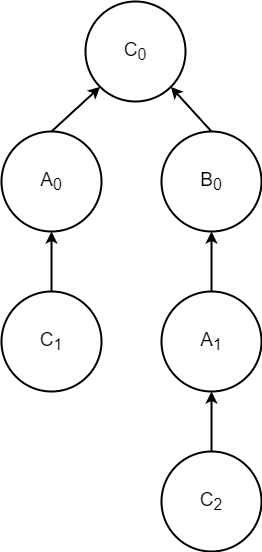
C0 开始,没有父节点,则不存在循环依赖。
从 A0 开始,A0 -> C0 ,该链路中也没有出现重复的 A 模块。
从 C1 开始,C1 -> A0 -> C0 ,该链路中 C 模块重复出现,则说明出现了循环依赖。
从 C2 开始,C2 -> A1 -> B0 -> C0 ,该链路中 C 模块重复出现,则说明出现了循环依赖。
模块初始化顺序
在生成模块树之后,通过对模块树进行后序遍历,可以保证正确的模块初始化顺序。
比如,有以下模块以及依赖。
[InjectModule<C>()]
[InjectModule<D>()]
class E:IModule
[InjectModule<A>()]
[InjectModule<B>()]
class C:IModule
[InjectModule<B>()]
class D:IModule
[InjectModule<A>()]
class B:IModule
class A:IModule
// E 是入口模块
services.AddModule<E>();
生成模块依赖树如图所示:
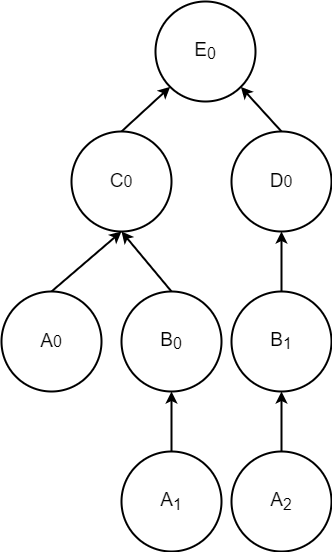
首先从 E0 开始扫描,因为 E0 下存在子节点 C0、 D0,那么就会先顺着 C0 再次扫描,扫描到 A0 时,因为 A0 下已经没有子节点了,所以会对 A0 对应的模块 A 进行初始化。根据上图模块依赖树进行后序遍历,初始化模块的顺序是(已经被初始化的模块会跳过):
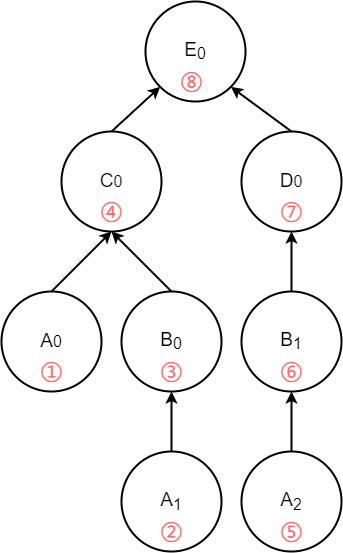
服务自动注册
Maomi.Core 是通过 [InjectOn] 特性注解识别如何注的服务到容器中,其定义如下:
/// <summary>
/// 将当前类型自动注册到容器中.
/// </summary>
[AttributeUsage(AttributeTargets.Class, AllowMultiple = false, Inherited = false)]
public class InjectOnAttribute : Attribute
{
/// <summary>
/// 要注册的服务类型.
/// </summary>
public Type[]? ServiceTypes { get; set; } = Array.Empty<Type>();
/// <summary>
/// 服务的生命周期.
/// </summary>
public ServiceLifetime Lifetime { get; set; } = ServiceLifetime.Scoped;
/// <summary>
/// 服务注册模式.
/// </summary>
public InjectScheme Scheme { get; set; }
/// <summary>
/// 将自己也注册到容器中.
/// </summary>
public bool Own { get; set; } = false;
/// <summary>
/// ServiceKey.
/// </summary>
public object? ServiceKey { get; set; }
/// <summary>
/// Initializes a new instance of the <see cref="InjectOnAttribute"/> class.
/// </summary>
/// <param name="lifetime">服务生命周期.</param>
/// <param name="scheme">服务注册模式.</param>
public InjectOnAttribute(ServiceLifetime lifetime = ServiceLifetime.Scoped, InjectScheme scheme = InjectScheme.OnlyInterfaces)
{
Lifetime = lifetime;
Scheme = scheme;
}
}
一共提供了四种注册方式,[InjectOn] 最基础的注册方式,其它三个特性类区别在于生命周期不同,四个特性类在其它方面的使用方式一致。
InjectOn
InjectOnScoped
InjectOnSingleton
InjectOnTransient
使用 [InjectOn] 时,默认是注册服务为 Scoped 生命周期,且注册所有接口。
会自动过滤 IDisposable、ICloneable 等接口,详细参考 自定义模块配置 。
[InjectOn]
public class MyService : IAService, IBService
或者使用:
[InjectOnScoped]
public class MyService : IAService, IBService
等同于:
services.AddScoped<IAService, MyService>();
services.AddScoped<IBService, MyService>();
如果只想注册 IAService,可以将注册模式设置为InjectScheme.Some ,然后自定义注册的类型:
[InjectOn(
Scheme = InjectScheme.Some,
ServicesType = new Type[] { typeof(IAService) }
)]
public class MyService : IAService, IBService
再例如只想注册 SomeB,则:
public class Some { }
public interface SomeA { }
public interface SomeB { }
public interface SomeC { }
[InjectOn(scheme: InjectScheme.Some, ServiceTypes = new Type[] { typeof(SomeB) })]
public class Service_Some : Some, SomeA, SomeB, SomeC { }
也可以把自身注册到容器中:
[InjectOn(Own = true)]
public class MyService : IMyService
等同于:
services.AddScoped<IAService, MyService>();
services.AddScoped<MyService>();
再如下代码所示:
public class Some { }
public interface SomeA { }
public interface SomeB { }
public interface SomeC { }
[InjectOn(scheme: InjectScheme.Some, Own = true, ServiceTypes = new Type[] { typeof(SomeB) })]
public class Service_Some : Some, SomeA, SomeB, SomeC { }
等同于:
services.AddScoped<SomeB, Service_Some>();
services.AddScoped<Service_Some>();
对于 Service_Some 的例子,如果服务继承了类、接口,只想注册接口,那么可以这样写:
public class Some { }
public interface SomeA { }
public interface SomeB { }
public interface SomeC { }
[InjectOn(scheme: InjectScheme.OnlyInterfaces)]
public class Service_Some : Some, SomeA, SomeB, SomeC { }
等同于:
services.AddScoped<SomeA, Service_Some>();
services.AddScoped<SomeB, Service_Some>();
services.AddScoped<SomeC, Service_Some>();
如果只注册自身,忽略接口等,可以使用 InjectScheme.None:
[InjectOn(ServiceLifetime.Scoped, Scheme = InjectScheme.None, Own = true)]
在 .NET 8 中,服务注册出现了 Keyed Service 方式,可以更加方便地实现工厂模式
可以为同一个服务添加不同的 Key,最简单的使用场景是为同一个接口提供不同的实现,通过 Key 引入对应的实现。
[InjectOnScoped(ServiceKey = "A")]
public class AService : IMyService
{
public int Sum(int a, int b)
{
return a + b;
}
}
[InjectOnScoped(ServiceKey = "B")]
public class BService : IMyService
{
public int Sum(int a, int b)
{
return a + b;
}
}
[InjectOnScoped(ServiceKey = "C")]
public class CService : IMyService
{
public int Sum(int a, int b)
{
return a + b;
}
}
在注入服务时,可以这样写:
private readonly IMyService _service;
public IndexController([FromKeyedServices("A")] IMyService service)
{
_service = service;
}
private readonly IMyService _service;
public IndexController(IServiceProvider serviceProvider)
{
_service = serviceProvider.GetKeyedService<IMyService>("A");
}
另外,基于模块类的 TypeFilter,读者也可以实现自己的自动服务注册和发现组件,有兴趣的读者可以自行编写。